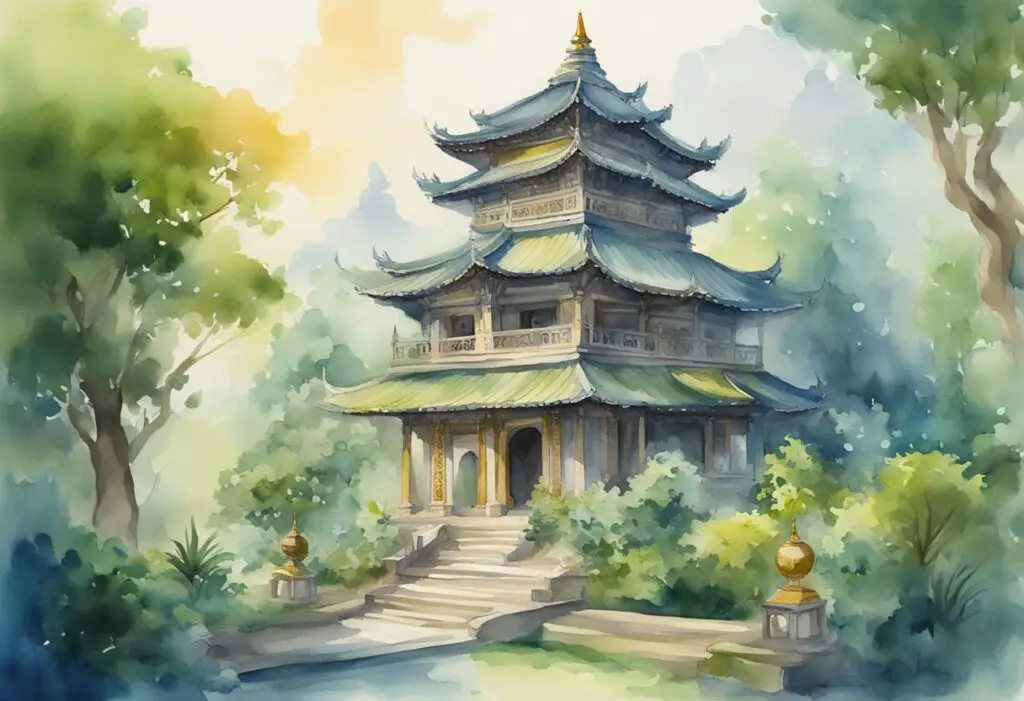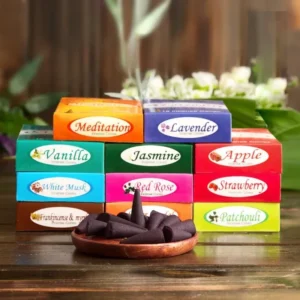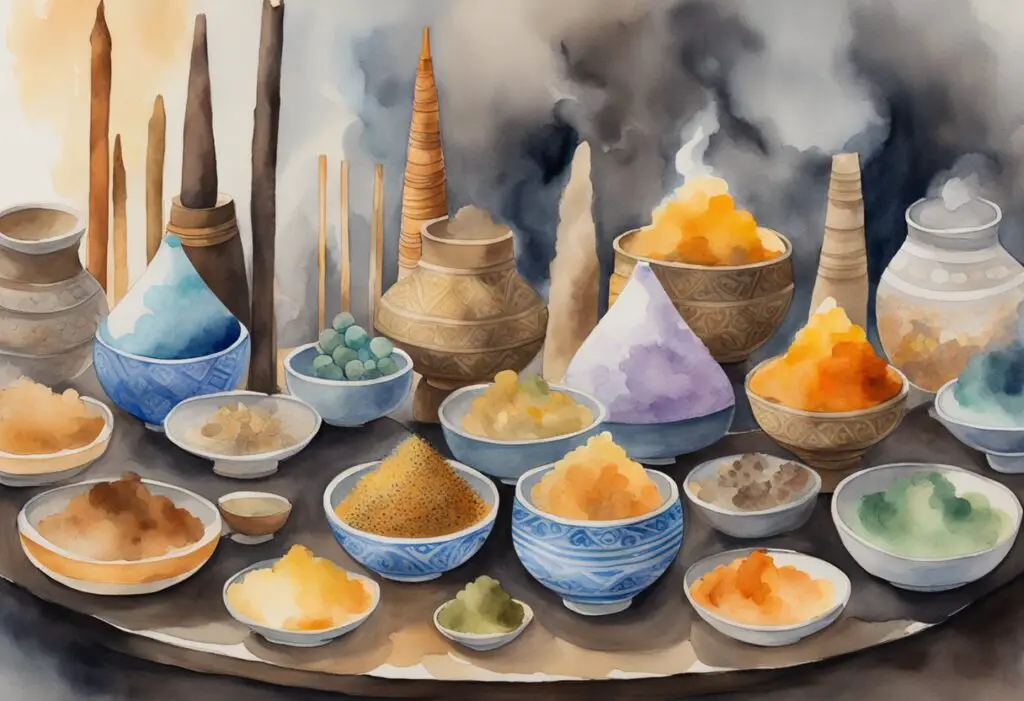Incense has woven itself deeply into the fabric of spiritual practices worldwide, entwining scents with memories and traditions. From the ancient temples of India to the serene shrines of Japan, incense transcends mere fragrance, becoming a vital participant in rituals and meditative journeys. You’re likely to discover that incense is cherished not just for its pleasing aromas, but for how it enhances your spiritual experiences by bridging the temporal with the divine.

Each puff of scented smoke is a page in the history of incense, telling stories that vary across cultures yet hold a universal significance. In many traditions, incense symbolizes purity and the elevation of the spirit. As you explore its historical roots, you may find that the cultural heritage associated with incense resonates with your own beliefs.
Engaging with the past of incense is like stepping into a time capsule. Its global journey—from sacred ceremonies in ancient Egypt to its significant role in Asian spirituality—illustrates not just a history of incense, but a shared human quest for meaning and transcendence. Through these traditions, you can see how the use of incense has intertwined with spirituality across centuries, offering a portal to connect with cultures and beliefs.
-

Frog Incense Stick Holder
$12.99 Add to cart -

Mahendra Incense Cones
$8.99 Select options This product has multiple variants. The options may be chosen on the product page
Origins and Historical Significance
Incense has played a crucial role in spiritual practices throughout history, influencing rituals and religious ceremonies across various ancient civilizations. Its trade and cultural spread enriched many societies, leaving a lasting spiritual and economic impact.
Ancient Civilizations and Incense
In ancient Egypt, incense was an integral part of religious and burial ceremonies. You might find it fascinating that they used resins like frankincense and myrrh, which were highly valued for their aromatic properties. Egyptians believed that burning incense was a way to communicate with the gods, as the smoke was thought to carry prayers to the heavens.
Moreover, in the Near East and the Mediterranean, incense served as offerings to deities and played a role in temple rituals. If you were a visitor to these ancient societies, you would have noticed how incense created a sacred atmosphere. It wasn’t just for aroma but was considered a vital element in spiritual experiences and ceremonies.
Incense in Religious and Spiritual Rituals
Across various religions, incense holds a special place. In Hinduism, for example, the burning of incense is believed to purify the environment and enhance concentration during meditation. The choice of incense types often correlates with local beliefs and traditions.
In Christian rituals, especially within the Catholic and Orthodox churches, you may observe incense used during mass and processions. The fragrant smoke symbolizes prayers rising to God, creating a sense of spirituality and reverence. Meanwhile, in Buddhist ceremonies, incense is used to honor the Buddha and is considered a symbolic offering of devotion.
The Trade and Cultural Spread of Incense
The trade of incense, especially frankincense and myrrh, was a major economic force in ancient times. If you think about the Silk Road, you might imagine luxuries such as silk and spices, but incense was equally significant. It linked regions from the Arabian Peninsula to ancient Rome, bringing wealth and cultural exchange.
The value of incense was so high that it sometimes served as currency. As you explore history, it’s intriguing to see how this trade enabled cultural interactions, influencing religious practices worldwide. Through these exchanges, local customs evolved, integrating new spiritual elements influenced by the presence of incense.
Forms and Types of Incense

Incense comes in various forms and types, each with its unique aromatic properties and cultural significance. These different forms include incense sticks, cones, and natural plant materials, all crafted from an array of fragrant sources like woods, resins, and spices.
Diverse Incense Materials and Aromatic Sources
From ancient times, different materials have been used to create incense, each offering distinct scents and purposes. You might come across aromatic woods such as sandalwood and cedar, which are known for their calming effects. Resins like amber and benzoin are often used in rituals due to their rich and soothing fragrances.
Spices such as cinnamon add a warm, inviting aroma to the mix. These components are blended in various ways to produce different types of incense, catering to your specific needs, whether for meditation or simply to enhance your personal space.
Each material used in incense provides not only a distinct aroma but also varies in terms of its cultural and traditional importance. For example, frankincense is widely used in religious ceremonies due to its long-standing spiritual significance.
Incense Sticks, Cones, and Other Forms
Incense is available in several forms, each offering a unique experience. Incense sticks are among the most popular, known for their ease of use and consistent burn. Simply light the tip, and you can enjoy a slow and steady release of fragrance.
Cone incense offers a different experience, often producing a more intense aroma due to its compact form. They burn faster than sticks and are perfect when you want a quick hit of fragrance. Other forms of incense include coils and powders, each with varying burn times and intensity.
Choosing between these forms depends on your preference and the specific ambiance you wish to create. Whether for relaxation, meditation, or just enjoying a pleasant scent, there’s an incense form suitable for you. This variety lets you tailor your aromatic experience to suit your lifestyle and needs.
Cultural Practices and Incense Usage
Incense has played a vital role in spiritual traditions worldwide, serving various functions from spiritual cleansing to symbolizing reverence in sacred spaces. Explore how incense is intertwined with both Eastern spiritual traditions and Western religious ceremonies.
Incense in Eastern Spiritual Traditions
In Eastern traditions, incense holds a significant place. In Buddhism, it connects practitioners to their inner spirituality during meditation, creating a calming atmosphere that enhances focus and mindfulness. Similarly, in Hinduism, you’ll notice incense used in puja rituals, believed to purify the space and mind, reinforcing the sacredness of the act. Jainism also incorporates incense; for Jains, it symbolizes detachment from worldly pleasures.
The cultural significance of incense in Eastern practices is profound. In East Asia, particularly during the Han Dynasty, incense became a staple in religious and cultural ceremonies. Taoism uses incense to establish a connection between the divine and earthly realms. Viewing incense as a bridge between the tangible and spiritual, ensures that the practice is deeply rooted in reverence and tradition.
Incense in Western Religious Ceremonies
In Western traditions, incense is equally influential but used differently. Within Christianity, incense is part of church rituals and services. It often signifies prayers rising to heaven. You’ll find it prominently used during masses and high ceremonies to sanctify and create a reverent space. This usage emphasizes the solemnity and holiness of the gathering, transforming the church into a sacred space.
Incense has been part of various rituals throughout Western history. It serves roles in spiritual cleansing, representing purity and preparation before engaging in sacred rites. This acts as a precursor to worship, facilitating a profound connection with the divine. The symbolism in Western contexts often reflects deep-rooted traditions that have evolved over centuries, yet consistently aim to elevate spiritual experiences.
Incense and Aromatherapy
Incense offers a delightful fusion of spirituality and aromatherapy. Its aromatic smoke has both therapeutic and meditative benefits that enhance spiritual practices. Discover how incense contributes to relaxation and clarity.
The Therapeutic Use of Aromatic Smoke
Many cultures use incense for its healing properties. The smoke from burning incense like sandalwood creates a calming atmosphere. It’s believed to promote relaxation and reduce stress. Using incense in your home can help you feel more at ease and may even enhance your mood.
Certain types of incense, such as white sage, are traditionally used in practices like smudging. This ritual is thought to cleanse spaces of negative energies. The therapeutic benefits of incense are not limited to mental health. Some believe the aromatic compounds can also have physical benefits, making it a popular choice in aromatherapy.
Incense in Meditation and Mindfulness
Incorporating incense into your meditation practice can deepen your experience. The scent acts as a focal point for mindfulness. Sandalwood incense, known for its soothing scent, is often used in meditation to help clear the mind.
Burning incense can create a peaceful environment that aids concentration and enhances your meditation. The specific aromas released help ground you in the present moment. By adding incense to your routine, you may find that your mindfulness practices become more fulfilling. It’s a simple yet effective way to transform your space into a sanctuary of tranquility.
Modern Incense and Its Evolving Role

Incense continues to play a pivotal role in modern spirituality and personal well-being. Its uses have expanded, influenced by contemporary lifestyles and the need for tranquility and spiritual growth in everyday life.
The Evolution of Incense in Contemporary Times
Modern incense is shaped by centuries-old incense traditions. Today, incense incorporates not just traditional fragrances but also new blends designed to resonate with the present-day spiritual seeker. This evolution reflects both historical reverence and adaptation to modern spiritual and aesthetic preferences.
In many cultures, incense serves as a tool for purification rituals, clearing negative energy, and inviting positive energy. You may find it used in meditation and prayer, enhancing spiritual awareness and focus. As you embrace these ancient practices, you also engage with a tradition that has been continuously evolving to suit the needs of its users.
Incense for Personal Well-being and Atmosphere
Using incense can significantly enhance your personal environment. Many people turn to incense for its ability to transform a space, creating a sense of tranquility and calm. Whether you’re meditating, practicing yoga, or simply aiming to relax after a long day, incense like opium incense can foster a soothing atmosphere conducive to inner peace and spiritual growth.
Modern blends often target well-being, using scents known to reduce stress and promote relaxation. Burning incense can be a simple yet powerful way to enrich your home with positive energy, making it a valuable tool in your journey towards spiritual and emotional balance.

